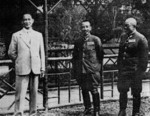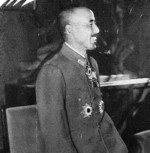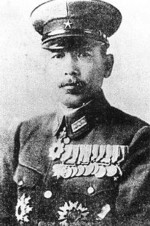Otozo Yamada
| Surname | Yamada |
| Given Name | Otozo |
| Born | 6 Nov 1881 |
| Died | 18 Jul 1965 |
| Country | Japan |
| Category | Military-Ground |
| Gender | Male |
Contributor: C. Peter Chen
ww2dbaseOtozo Yamada was born in Nagano Prefecture, Japan in 1881. In May 1901, he graduated from the Army Junior Academy. In Nov 1902, he graduated from the Japanese Army Academy. In Jun 1903, he was promoted to the rank of sub-lieutenant. In 1904, he saw action in the Russo-Japanese War. He was promoted to the rank of lieutenant in Feb 1905 and served as an instructor at the academy. In Sep 1912, he was promoted to the rank of captain. In Nov 1912, he completed his studies at the Army Staff College. In Aug 1913, he was attached to the Japanese Army Chiefs of Staff. In Jun 1918, he was promoted to the rank of major and was made an instructor at the cavalry school. In Aug 1922, he was promoted to the rank of lieutenant colonel and was assigned to the department overseeing the discipline and punishment of cavalry officers and men. In Feb 1924, he was made the commanding officer of the 26th Cavalry Regiment. In Aug 1925, he was promoted to the rank of colonel. In Mar 1926, he was made the chief of staff of the Japanese Chosen Army. Between Jul 1927 and Aug 1930, he served in the communications section of the 3rd Bureau of the Japanese Army General Staff. In Aug 1930, he was promoted to the rank of major general and was made the chief of cavalry training. Between Aug 1931 and Aug 1932, he was the commanding officer of the 4th Cavalry Brigade. In Aug 1932, he was made the Commandant of the Army Communications School. In Aug 1933, he was made the chief of the 3rd Department under the Army Chief of Staff. In Aug 1934, he was promoted to the rank of lieutenant general and was made the Army Chief of Staff. In Aug 1935, while retaining his position as the Army Chief of Staff, he took on the concurrent duty as the chief of the 3rd Department. In Dec 1935, he was made the Commandant of the Army Military Academy. In Mar 1937, he was made the commanding officer of the 12th Division based in the puppet state of Manchukuo in northeastern China; in this role, he was known for his brutally effective methods in eliminating Chinese Communist forces in northeastern China and for his usage of military forces to enforce Manchukuo taxation. In Jan 1938, he was made the commanding officer of the 3rd Army. In Dec of the same year, he was made the commanding officer of the Central China Expeditionary Army. In Oct 1939, he returned to Japan to served as the Inspector General of Military Training with concurrent duty as a staff officer under the Army Chief of Staff. In Aug 1940, he was promoted to the rank of general. In Dec 1940, he was detached from the office of the Army Chief of Staff. In Jul 1944, he returned to northeastern China as the commanding officer of the Kwangtung Army. In this role, he paid particular attention to the progress of Unit 731, which conducted biological warfare research using Chinese civilians as test subjects. He was quoted as saying that Japan lacked resources to build large amounts of conventional armament, thus it was necessary for Japan to advance unconventional weapons such as biological weapons. When the Soviet Union tore up the non-aggression pact in the final days of the war, he raised a large conscript army in an attempt to slow the advances of the Soviets in order to buy his regular troops time to prepare defenses, but the conscript force would be wiped out within days. When the end became inevitable, he ordered Unit 731 personnel to move toward southern Korea and the destruction of equipment and records that could become evidence for war crimes. On 19 Aug 1945, Soviet SMERSH agents were able to convince him to issue the order to surrender. Captured, he was initially imprisoned in Chia, Chita Oblast, Russia, then in Khabarovsk, Khabarovsk Krai, Russia. At the latter location, he was tried for war crimes and was found guilty. He was sentenced to 25 years hard labor, largely for the deeds of Unit 731. In 1956, after only 7 years into his prison term, he was released and repatriated back to Japan as a part of the actions taken by the Soviet Union as the Soviet Union attempted to improve its relations with Japan. Yamada passed away in Tokyo, Japan in 1965.
ww2dbaseSource: Wikipedia
Last Major Revision: Dec 2014
Photographs
 |  |  |  |
Otozo Yamada Timeline
| 6 Nov 1881 | Otozo Yamada was born in Nagano Prefecture, Japan. |
| 18 Jul 1944 | Otozo Yamada succeeded Yoshijiro Umezu as the commanding officer of the Japanese Kwantung Army in northeastern China. |
| 14 Jun 1945 | Otozo Yamada met with his top Kwangtung Army officers in Xinjing (Changchun), China to plan defenses against a potential Soviet invasion. |
| 19 Aug 1945 | Soviet SMERSH operatives convinced General Otozo Yamada to surrender at Xinjing (Changchun), China. |
| 18 Jul 1965 | Otozo Yamada passed away in Tokyo, Japan. |
Did you enjoy this article or find this article helpful? If so, please consider supporting us on Patreon. Even $1 per month will go a long way! Thank you. Share this article with your friends: Stay updated with WW2DB: |
» Manchurian Strategic Offensive
» Tokyo Trial and Other Trials Against Japan
- » 1,150 biographies
- » 337 events
- » 43,917 timeline entries
- » 1,241 ships
- » 350 aircraft models
- » 207 vehicle models
- » 374 weapon models
- » 123 historical documents
- » 260 facilities
- » 470 book reviews
- » 28,542 photos
- » 432 maps
Joachim von Ribbentrop, German Foreign Minister, Aug 1939
Please consider supporting us on Patreon. Even $1 a month will go a long way. Thank you!
Or, please support us by purchasing some WW2DB merchandise at TeeSpring, Thank you!